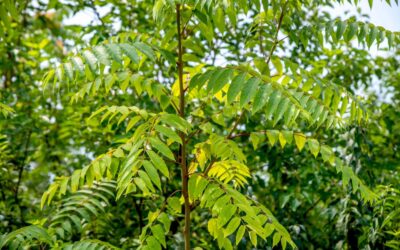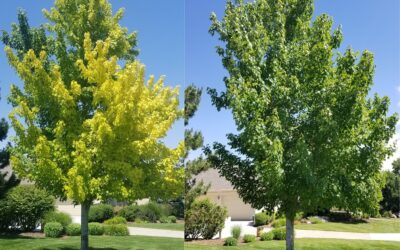From the mythical forests of Robin Hood to the parks of Denver, the majestic English oak has graced temperate climate landscapes for centuries. And centuries is a key word when talking about English oaks—they live for hundreds of years, especially when well cared for. The oldest living specimens are in Bulgaria and Lithuania, estimated to be around 1,500 years old.
Characteristics
The English oak is a large shade tree, growing to a height of 50-60 feet with a mature spread of 35-45 feet. Young trees start in a pyramid shape, maturing into dense canopies of dark green lobed leaves with strong central trunks covered in deeply furrowed grey bark. Trunks can range from a few feet in diameter at maturity to as much as 40 feet in the most ancient specimens. The leaves are of a type called marcescent, meaning they stay on the tree through the dormant period, falling only when new leaf buds force them off the branches. This can add extra winter interest to a landscape.
Sometimes called a truffle oak, English oaks sprout acorns in mid-spring that ripen and fall in autumn. The English oak’s acorn is distinct from most other oaks in that it is oblong rather than round, typically about an inch in length.
Benefits
The acorns provide food for squirrels and other small mammals. Some birds, notably jays, feed on the acorns, too, and the high branches offer shelter to many other species while supporting a large population of beneficial insects.
English oaks have not been widely planted in Colorado due to the abundance of other native and hybrid species, but are strong, disease-resistant trees that do well in our climate and offer a different look with their distinctive conical shape. They’re excellent shade trees due to their span and have about six feet of clearance under their branches when mature.
Considerations
English oaks are great as specimen trees and in landscaping. Due to their height, these relatively fast-growing trees should be planted in places they won’t interfere with power lines and other overhead obstructions and have room to spread their branches.
They produce lots of acorns, which can be messy if not cleaned up or carried off by wildlife. And while their leaves may stay attached through the winter, they will eventually fall and need to be dealt with like any other deciduous tree.
Conclusion
The English oak is a healthy and hardy tree that will add interest to any Front Range landscape roomy enough to accommodate it. While it naturalizes easily in a variety of growing conditions, pruning techniques known as pollarding and coppicing will extend the tree’s life and health.
Properly chosen and maintained trees are an important investment that can add considerable value to both residential and commercial property. Donovan Arborists offers planting, pruning, and shearing services for English oaks and other trees and shrubs as well as a complete landscape maintenance package for property in the Denver area.
We’re always happy to give free estimates to homeowners and property managers for any services they may need.



